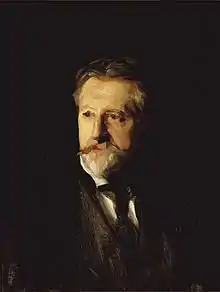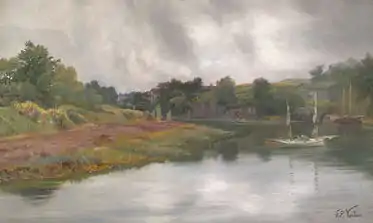Frederic Porter Vinton
Frederic Porter Vinton (January 29, 1846 – May 19, 1911), sometimes spelled "Frederick", was an American portrait painter.
Frederic Porter Vinton | |
|---|---|
 1903 portrait by John Singer Sargent | |
| Born | January 29, 1846 Bangor, Maine, U.S. |
| Died | May 19, 1911 (aged 65) Boston, Massachusetts, U.S. |
| Nationality | American |
| Known for | Painting |
| Movement | Impressionism |
Life
He was born in Bangor, Maine.[1] He grew up in Chicago, and moved to Boston in 1861[2] For twenty years he worked as a bookkeeper, during which he studied art under William Rimmer at the Lowell Institute. Soon after studying at the Institute, he wrote an art review for the Boston Advertiser.[2] He opened a portrait studio in Boston in 1878. After his studio picked up business, he traveled abroad in Europe for eighteen months, then returned to marry Annie M. Pierce on June 27, 1883.[2] His first exhibition was in 1880, which showed a portrait of his. He contributed his art to the exhibit every year until 1883, in which political unrest in the Academy in which the exhibit belonged forced him to resign for a year. In 1884 he submitted "Street in Toledo", the first of his landscapes to be submitted. Everything before it was a portrait of some kind.[2] In 1891 he was elected a full member of the National Academy of Design, New York City.[1]
Frederic moved to Chicago with his parents when he was ten. Then, five years later, his family moved to Boston. After first working as a clerk, he for short time was a banker, and then worked as a bookkeeper.[2][3] While a bookkeeper, he began studying art under William Rimmer of the Lowell Institute. Upon prompting from Rimmer, Vinton sent a review of some local artwork to the Boston Advertiser. In 1878 he began his artistic career by starting a small portrait studio in Boston.
Vinton married Annie M. Peirce on June 27, 1883, after an eighteen-month trip across Europe, visiting the Netherlands, France, and Germany. Some of his most famous paintings of portraits of his young wife.[4]
Paintings
Frederic specialized in portraits, although he had done some landscapes, such as "Street in Toledo" and "River View, Spring". His paintings have been described as impressionistic.[5] Some critiques have gone as far as to say his work was, more specifically, pre-1940's impressionism. His work was also highly influenced by his European travels, and his studies under many important artists of the time.[6] It is associated with the Boston School of painting.[7]
European travels

Frederic spent much of his time traveling the European continent, and it has influenced his work and differentiated it from the American work of the same time, with one reviewer even calling him "an aristocrat of the old school."[6][8] In 1875, he traveled to Paris and studied under Léon Bonnat for a season. In 1876, he spent a year in Munich in which he spent his time learning under the teachings of Frank Duveneck and the Royal Academy of Munich.[1] Later, he returned to Paris for two years, citing his dislike of the German method of impressionism,[2] which included artists such as Lovis Corinth or Max Liebermann. While back in France, joined the Acadèmie Julian and was taught under Jean-Pual Lauren.[2] In 1882 he traveled to Spain with Robert Blum and William Merritt Chase.[6] The three artists spent time in Madrid and Toledo, and Frederic studied portraiture by studying Velázquez's previous work.[6]
Death
Vinton died of a bronchial affection in his home in Boston on May 20, 1911.[9][10] After his death, Mrs. Frederic Porter Vinton released some of his paintings to assorted exhibits.[11]
Notes
- Chisholm 1911.
- Dearinger 2004, p. 554
- Quick 1981, p. 192
- Pisano 2007, p. 109
- Rosenfeld 1991, p. 122
- Boone 2007, p. 147
- Gammell, R. H. Ives (1986). The Boston Painters, 1900-1930. Boston, MA: Parnassus Imprints. p. 43. ISBN 9780940160316.
- von Mach 1908, p. 118
- American Art Annual, Volume 9. MacMillan Company. 1911. p. 319.
- Shaw 1911, p. 676
- Rosenfeld 1991, p. 120
Attribution:
- Chisholm, Hugh, ed. (1911). . Encyclopædia Britannica. Vol. 28 (11th ed.). Cambridge University Press. p. 101.
References
- Dearinger, David (2004), Paintings and Sculpture in the Collection of the National Academy of Design, Hudson Hills, ISBN 1-55595-029-9
- Boone, Mary Elizabeth (2007), Vistas de España: American Views of Art and Life in Spain, 1860-1914, Yale University Press, ISBN 978-0-300-11653-3
- Rosenfeld, Daniel (1991), European Painting and Sculpture, Ca. 1770-1937, in the Museum of Art, Rhode Island, University of Pennsylvania Pree, ISBN 0-911517-55-3
- Pisano, Ronald G. (2007), William Merritt Chase: Portraits in Oil, Yale University Press, ISBN 978-0-300-11021-0
- Quick, Michael (1981), American Portraiture in the Grand Manner, 1720-1920, Los Angeles Country Museum of Art
- Shaw, Albert (1911), The American Review of Reviews, University of Michigan
- von Mach, Edmund (1908), The Art of Painting in the Nineteenth Century, Glinn and Company